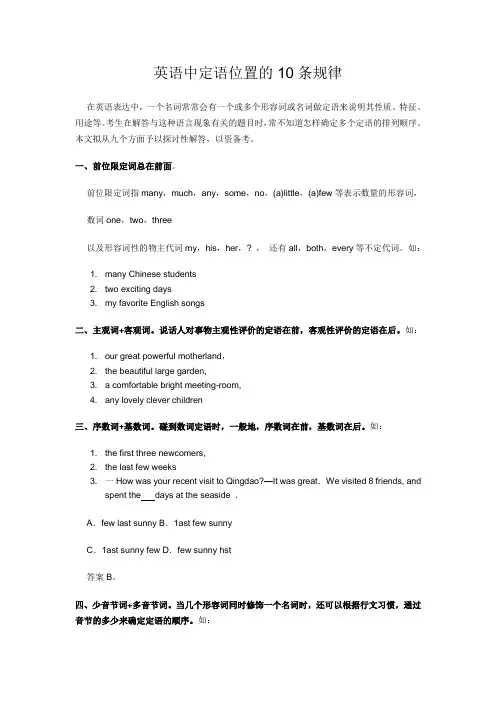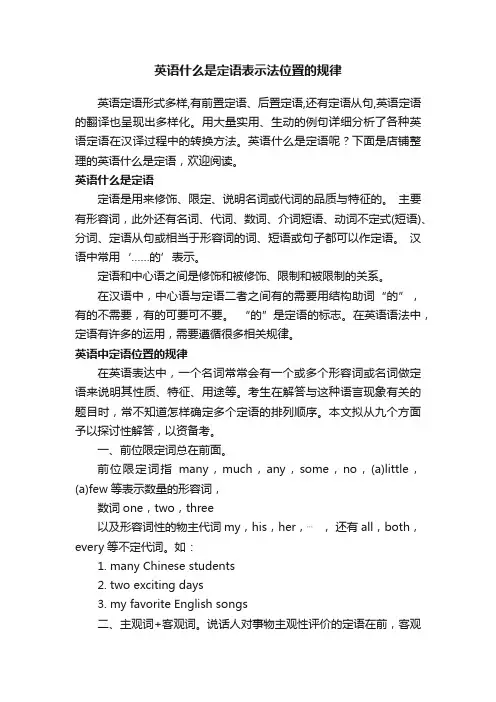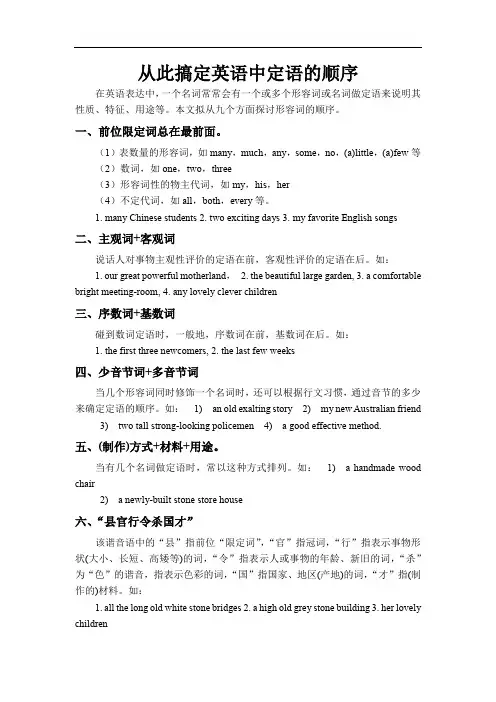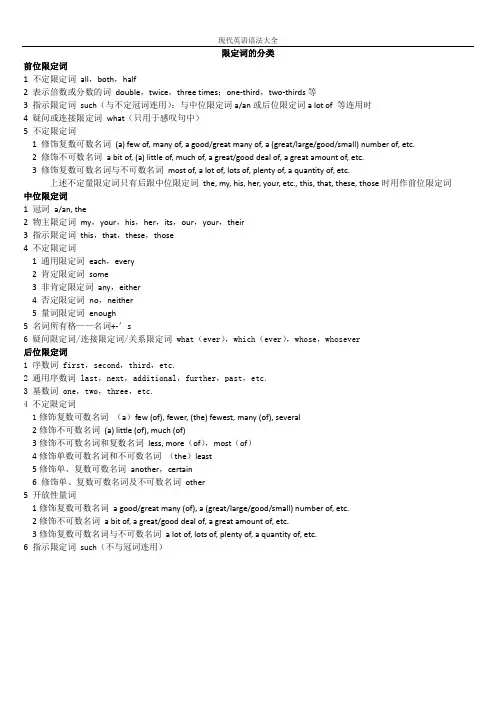前位限定词
- 格式:ppt
- 大小:69.00 KB
- 文档页数:3

名词前多个形容词的排列顺序英语中多个形容词作前置定语,其词序不同于汉语。
总规则如下:1、限定词限定词位于各类形容词之首。
它本身分为三位。
即:前位、中位和后位,词序为前、中、后。
①前位限定词:有all, half, both, such分数和倍数。
②中位限定词:有冠词,指示代词,形容词性物主代词,名词所有格和no, every, each, either, neither, enough, much等,以及wh-起首的限定词[what(ever), which(ever), whose等]。
③后位限定词:有基数词和序数词,past, same, many, more, most, few, fewer, fewest, little, less, least, own和last等。
序数词在前,基数词后在。
例如:I haven’t seen the vase before.I like this pretty car.2、描绘类描绘类形容词表示事物的性质及人们的观点,先短词后长词。
如:cold, great, bad, beautiful kind, fine, interesting, good等。
例如I haven’t seen such a beautiful vase before.I like the first two pretty cars.3、形状类形状类形容词表示大小、长短、高低(矮)、外形、干湿度等。
如:large, big, small, little, long, short, low, round, wet, dry等。
例如:I haven’t seen such a beautiful big vase before.I like the first two pretty small cars.4、时间类时间类形容词表示年龄,长幼、时代,新旧、气候,温度等。
如:new, old, hot, new, little, old, young, cool, wet, dry等。

从此搞定英语中定语的顺序————————————————————————————————作者:————————————————————————————————日期:ﻩ从此搞定英语中定语的顺序在英语表达中,一个名词常常会有一个或多个形容词或名词做定语来说明其性质、特征、用途等。
本文拟从九个方面探讨形容词的顺序。
一、前位限定词总在最前面。
(1)表数量的形容词,如many,much,any,some,no,(a)little,(a)few等(2)数词,如one,two,three(3)形容词性的物主代词,如my,his,her(4)不定代词,如all,both,every等。
1. many Chinese students 2. two exciting days 3.my favoriteEnglish songs二、主观词+客观词说话人对事物主观性评价的定语在前,客观性评价的定语在后。
如:1. our great powerful motherland, 2.the beautiful large garden, 3. a comfortable bright meeting-room, 4. anylovely clever children三、序数词+基数词碰到数词定语时,一般地,序数词在前,基数词在后。
如:1.the firstthree newcomers, 2. the lastfewweeks 四、少音节词+多音节词当几个形容词同时修饰一个名词时,还可以根据行文习惯,通过音节的多少来确定定语的顺序。
如: 1)anoldexalting story 2)my new Aus tralianfriend3)two tallstrong-lookingpolicemen 4) a good effective method.五、(制作)方式+材料+用途。
当有几个名词做定语时,常以这种方式排列。

英语中定语位置的10条规律在英语表达中,一个名词常常会有一个或多个形容词或名词做定语来说明其性质、特征、用途等。
考生在解答与这种语言现象有关的题目时,常不知道怎样确定多个定语的排列顺序。
本文拟从九个方面予以探讨性解答,以资备考。
一、前位限定词总在前面。
前位限定词指many,much,any,some,no,(a)little,(a)few等表示数量的形容词,数词one,two,three以及形容词性的物主代词my,his,her,? ,还有all,both,every等不定代词。
如:1. many Chinese students2. two exciting days3. my favorite English songs二、主观词+客观词。
说话人对事物主观性评价的定语在前,客观性评价的定语在后。
如:1. our great powerful motherland,2. the beautiful large garden,3. a comfortable bright meeting-room,4. any lovely clever children三、序数词+基数词。
碰到数词定语时,一般地,序数词在前,基数词在后。
如:1. the first three newcomers,2. the last few weeks3. 一How was your recent visit to Qingdao?—It was great.We visited 8 friends, andspent the days at the seaside .A.few last sunny B.1ast few sunnyC.1ast sunny few D.few sunny hst答案B。
四、少音节词+多音节词。
当几个形容词同时修饰一个名词时,还可以根据行文习惯,通过音节的多少来确定定语的顺序。
如:1) an old exalting story2) my new Australian friend3) two tall strong-looking policemen4) a good effective method.五、(制作)方式+材料+用途。


英语什么是定语表示法位置的规律英语定语形式多样,有前置定语、后置定语,还有定语从句,英语定语的翻译也呈现出多样化。
用大量实用、生动的例句详细分析了各种英语定语在汉译过程中的转换方法。
英语什么是定语呢?下面是店铺整理的英语什么是定语,欢迎阅读。
英语什么是定语定语是用来修饰、限定、说明名词或代词的品质与特征的。
主要有形容词,此外还有名词、代词、数词、介词短语、动词不定式(短语)、分词、定语从句或相当于形容词的词、短语或句子都可以作定语。
汉语中常用‘……的’表示。
定语和中心语之间是修饰和被修饰、限制和被限制的关系。
在汉语中,中心语与定语二者之间有的需要用结构助词“的”,有的不需要,有的可要可不要。
“的”是定语的标志。
在英语语法中,定语有许多的运用,需要遵循很多相关规律。
英语中定语位置的规律在英语表达中,一个名词常常会有一个或多个形容词或名词做定语来说明其性质、特征、用途等。
考生在解答与这种语言现象有关的题目时,常不知道怎样确定多个定语的排列顺序。
本文拟从九个方面予以探讨性解答,以资备考。
一、前位限定词总在前面。
前位限定词指many,much,any,some,no,(a)little,(a)few等表示数量的形容词,数词one,two,three以及形容词性的物主代词my,his,her,⋯,还有all,both,every等不定代词。
如:1. many Chinese students2. two exciting days3. my favorite English songs二、主观词+客观词。
说话人对事物主观性评价的定语在前,客观性评价的定语在后。
如:1. our great powerful motherland,2. the beautiful large garden,3. a comfortable bright meeting-room,4. any lovely clever children三、序数词+基数词。

从此搞定英语中定语的顺序在英语表达中,一个名词常常会有一个或多个形容词或名词做定语来说明其性质、特征、用途等。
本文拟从九个方面探讨形容词的顺序。
一、前位限定词总在最前面。
(1)表数量的形容词,如many,much,any,some,no,(a)little,(a)few等(2)数词,如one,two,three(3)形容词性的物主代词,如my,his,her(4)不定代词,如all,both,every等。
1. many Chinese students2. two exciting days3. my favorite English songs二、主观词+客观词说话人对事物主观性评价的定语在前,客观性评价的定语在后。
如:1. our great powerful motherland,2. the beautiful large garden,3. a comfortable bright meeting-room,4. any lovely clever children三、序数词+基数词碰到数词定语时,一般地,序数词在前,基数词在后。
如:1. the first three newcomers,2. the last few weeks四、少音节词+多音节词当几个形容词同时修饰一个名词时,还可以根据行文习惯,通过音节的多少来确定定语的顺序。
如:1) an old exalting story 2) my new Australian friend3) two tall strong-looking policemen 4) a good effective method.五、(制作)方式+材料+用途。
当有几个名词做定语时,常以这种方式排列。
如:1) a handmade wood chair2) a newly-built stone store house六、“县官行令杀国才”该谐音语中的“县”指前位“限定词”,“官”指冠词,“行”指表示事物形状(大小、长短、高矮等)的词,“令”指表示人或事物的年龄、新旧的词,“杀”为“色”的谐音,指表示色彩的词,“国”指国家、地区(产地)的词,“才”指(制作的)材料。

Pre-, central, and post- determiner
’前位限定词:部分不定限定词all, such, both 等、倍数词double等、分数词one-third等。
’中位限定词:冠词a等、指示词this等、形容词性物主代词my等、名词属格Mary’s等、某些不定限定词some, every, each, either, enough 等、以wh-为首的限定词what等。
’后位限定词:基数词one等、序数词first等、某些不定限定词many, little, several等、以及last, next, other, another, such等。
’前+中+后; 前+中;中+后;后+后
示例:
All the four teachers
All your three books
All these last few days
Half his lecture
Those last few days
All other students
Such a misfortune
My that book
关于such跨类的说明
such既属于前位限定词,又可归入后位限定词。
由于它只是在such a...和such an...这样的搭配中属于前位限定词,而在与其他限定词(some, any, no, all, few, another, other, many, one, two, etc)搭配时,such则是后位限定词,一律放在上述这些限定词的后面,如some such, any such, no such, few such, one such等。

限定词的分类前位限定词1 不定限定词all,both,half2 表示倍数或分数的词double,twice,three times;one-third,two-thirds等3 指示限定词such(与不定冠词连用):与中位限定词a/an或后位限定词a lot of 等连用时4 疑问或连接限定词what(只用于感叹句中)5 不定限定词1 修饰复数可数名词(a) few of, many of, a good/great many of, a (great/large/good/small) number of, etc.2 修饰不可数名词a bit of, (a) little of, much of, a great/good deal of, a great amount of, etc.3 修饰复数可数名词与不可数名词most of, a lot of, lots of, plenty of, a quantity of, etc.上述不定量限定词只有后跟中位限定词the, my, his, her, your, etc., this, that, these, those时用作前位限定词中位限定词1 冠词a/an, the2 物主限定词my,your,his,her,its,our,your,their3 指示限定词this,that,these,those4 不定限定词1 通用限定词each,every2 肯定限定词some3 非肯定限定词any,either4 否定限定词no,neither5 量词限定词enough5 名词所有格——名词+-'s6 疑问限定词/连接限定词/关系限定词 what(ever),which(ever),whose,whosever后位限定词1 序数词 first,second,third,etc.2 通用序数词 last,next,additional,further,past,etc.3 基数词 one,two,three,etc.4 不定限定词1修饰复数可数名词(a)few (of), fewer, (the) fewest, many (of), several2修饰不可数名词(a) little (of), much (of)3修饰不可数名词和复数名词less, more(of),most(of)4修饰单数可数名词和不可数名词(the)least5修饰单、复数可数名词another,certain6 修饰单、复数可数名词及不可数名词other5 开放性量词1修饰复数可数名词a good/great many (of), a (great/large/good/small) number of, etc.2修饰不可数名词a bit of, a great/good deal of, a great amount of, etc.3修饰复数可数名词与不可数名词a lot of, lots of, plenty of, a quantity of, etc.6 指示限定词such(不与冠词连用)限定词与名词的搭配关系A 只修饰单数可数名词的限定词前位限定词what a;中位限定词a/an, each, every, either, neither;后位限定词many a, one, etc.B 只修饰复数可数名词的限定词前位限定词both后位限定词two,three,etc.,(a) few, fewer, (the) fewest, many, several, these, those.前位限定词或后位限定词a good/great many (of), a (great/good/small) number of, etc.C 只能与不可数名词连用的后位(或前位)限定词(a)bit of, a good deal of, a great deal of, a great amount of, (great/large) amounts of, (a) little (of), much (of) D 只与单数和复数可数名词连用的后位限定词first, second, third, etc., last, next, another, (a) certain, etc.E 只与不可数名词和复数可数名词连用的限定词中位限定词enough, 零冠词后位限定词less, more, most, a lot of, lots of, plenty of, a quantity ofF 只与单数可数名词及不可数名词连用的限定词中位限定词this, that后位限定词(the) leastG可与单、复数可数名词及不可数名词连用的限定词前位限定词all, half, double, twice, three times, one-third, two-thirds, such中位限定词the, my, your, etc., some, any, either, no, what(ever), which(ever), whose, whosever, 名词所有格后位限定词additional, further, past, other, such代词分类表。

限定词的排序:前位限定词(指量限定词all, both, half等;倍数词double, twice等;分数词one-third, two-fifths等) +中位限定词(冠词;指示代词;形容词性物主代词;名词所有格)+后位限定词(序数词及last, next等;基数词及few, several等)等。
如:1. The husband gave his wife ________ every month in order to please her. (重庆卷)A. all half his incomeB. his half all incomeC. half his all incomeD. all his half income【分析】答案选A。
all和half都是前位限定词,his是中位限定词,所以his要位于all和half之后,只有A正确。
2. —How was your recent visit to Qingdao?—It was great. We visited some friends, and spent the ________ days at the seaside. (全国卷)A. few last sunnyB. last few sunnyC. last sunny fewD. few sunny last【分析】答案选B。
last, few是限定词,sunny是描绘性形容词,根据“限定词+形容词”的原则,排除C的原则,排除和D。
又根据“序数词(包括last, past, next, another等)+基数词(包括few, several等)”的原则,排除A。
兼有两种形式的副词1)close与closelyclose意思是"近";closely 意思是"仔细地"。
例如:He is sitting close to me. 他就坐在我边上。

英语中定语位置的10条规律在英语表达中,一个名词常常会有一个或多个形容词或名词做定语来说明其性质、特征、用途等。
考生在解答与这种语言现象有关的题目时,常不知道怎样确定多个定语的排列顺序。
本文拟从九个方面予以探讨性解答,以资备考。
一、前位限定词总在前面。
前位限定词指many,much,any,some,no,(a)little,(a)few等表示数量的形容词,数词one,two,three以及形容词性的物主代词my,his,her,⋯,还有all,both,every等不定代词。
如:1.m any Chinese students2.t wo exciting days3.m y favorite English songs二、主观词+客观词。
说话人对事物主观性评价的定语在前,客观性评价的定语在后。
如:1.o ur great powerful motherland,2.t he beautiful large garden,3.a comfortable bright meeting-room,4.a ny lovely clever children三、序数词+基数词。
碰到数词定语时,一般地,序数词在前,基数词在后。
如:1.t he first three newcomers,2.t he last few weeks3.一How was your recent visit to Qingdao?—It was great.We visited 8friends, and spent the days at the seaside .A.few last sunny B.1ast few sunnyC.1ast sunny few D.few sunny hst答案B。
四、少音节词+多音节词。
当几个形容词同时修饰一个名词时,还可以根据行文习惯,通过音节的多少来确定定语的顺序。
如:1) an old exalting story2) my new Australian friend3) two tall strong-looking policemen4) a good effective method.五、(制作)方式+材料+用途。

限定词顺序口诀及解析前位限定词:such,what,half,both,all百分比,分(数),倍(数)属前位水火不容,避同现中位限定词:中位阵容很庞大形容词性物主代,冠词,名词格,指示代,连词,不定限定词包括哪些要记清同时出现有条件巧用of来转换后位限定词:序数与类序基数与量数先序后基可共存量词在基后面跟量词与名词紧相邻形影不离不拆散(1)前位限定词包括:①不定限定词(Indefinite determiner)all,both,half②倍数词(Multiplicative numeral)double,twice,three times,etc.③分数词(Fractional numeral)one-third,two-fifths,etc;④what,such,(a/an),etc(2)中位限定词包括:①定冠词(Definite article)the;②不定冠词(Indefinite article)a,an③零冠词(Zero article)④指示限定词(Demonstrative determiner)this,that,these,those⑤物主限定词(Possessive determiner)my,your,his,her,our,your,their,one’s,its⑥名词属格(Genitive noun)Tom’s,my father’s;⑦不定限定词(Indefinite determiner)some,any,no,every,each,either,neither,enough;⑧连接代词what(ever),which(ever),whose,so……that,etc(3)后位限定词包括:①基数词(Cardinal numeral)one,two,three,etc;②序数词(Ordinal numeral)first,second,third,etc;③类序数词next,last,other,another,etc;④量词(Quantifier)many,much,(a)few,(a)little,fewer,(the)fewest,less,(the)least,more,most;several,plenty of,a lot of,lots of,a great/large/good number of,a great/good deal of,a large/small amount of;⑤such,etc限定词之间的搭配顺序:前+中+后根据限定词在名词前的位置关系,即如果一个名词词组带有上述三类限定词,其搭配关系总是按照前位词放在第一位,中位限定词放在第二位,接着是后位限定词,即按“前位—中位—后位”的顺序排列。
adj.作定语的顺序:在英语中,当名词有多个形容词修饰时,就有它们的先后顺序。
下面的口诀可帮你记住这一先后顺序,也是解题的关键。
限定描绘大长高,形状年龄和新老;颜色国籍跟材料,作用类别往后靠;其中,“限定词”包括:冠词、物主代词、指示代词、或数词,它位于各类形容词前。
它本身分为三位,即:前、中、后。
前位限定词有all、half、both、分数和倍数;中位限定词有冠词、指示代词、物主代词等;后位限定词有基数词和序数词,但序数词位于基数词前。
如:both my hands、all half his income等。
“描绘”性形容词如:beautiful、bad、cold、great等。
“大长高”表示大小、长短、高低等一些词。
表示“形状”的词如:round square等。
“国籍”指一个国家或地区的词。
“材料”的词如:wooden, woolen, stone,silk等。
“作用类别”的词如:medical, college,writing desk,police car等)。
形容词并列的顺序?
在英语中,当名词有多个形容词修饰时,就有它们的先后顺序。
下面的口诀可帮你记住这一先后顺序。
限定描绘大长高,
形状年龄和新老;
颜色国籍跟材料,
作用类别往后靠;
其中,“限定词”包括:冠词、物主代词、指示代词、或数词,它位于各类形容词前。
它本身分为三位,即:前、中、后。
前位限定词有all、half、both、分数和倍数;中位限定词有冠词、指示代词、物主代词等;后位限定词有基数词和序数词,但序数词位于基数词前。
如:both my hands、all half his income等。
“描绘”性形容词如:beautiful、bad、cold、great等。
“大长高”表示大小、长短、高低等一些词。
表示“形状”的词如:round square等。
“国籍”指一个国家或地区的词。
“材料”的词如:wooden, woolen, stone,silk等。
“作用类别”的词如:medical, college,writing desk,police car等。
such做限定词成分分析
关于限定词的二条重要规则:
1、如果一个名词前有不止一个限定词时,限定词必须按照前位、中位和后位的顺序排列,不允许颠倒。
2、前位限定词互相排斥,中位限定词互相排斥,但后位限定词不互相排斥,只要逻辑不矛盾,可以同时使用二个或更多的后位限定词。
前位限定词:all, both, 倍数词,分数词,what (a), such (a) 中位限定词:冠词、指示代词、疑问代词、关系代词、人称代词、名词所有格、some, any, no, each, every, either, neither,enough 后位限定词:基数词,序数词,many, much, more, most, few, fewer, fewest, little, less, least, other, another, several, such.
such和a/an连用时,为前位限定词,没有a/an时,为后位限定词。
感叹代词what与a/an连用时,为前位限定词,没有a/an时,为中位限定词。
汉译英错误分析:
我公司没有这样一个人。
There is no such a man in our company. (误)
There is no such man in our company. (正)
There is not such a man in our company. (正)
分析:such与a连用,为前位限定词,no为中位限定词,不定
冠词为中位限定词。
第一句犯了两个原则性错误,一个是前位限定词such和中位限定词no位置颠倒;另一个是一个名词前用了二个中位限定词。
no=not any或not a.。